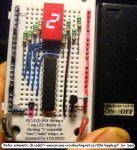well im fairly new to the picaxe i have a electronics background but i don't know S**T about programing. iv been working on a picaxe controlled LCD project that is like 94% done. and ive stumbled my way through most of it.
i was looking at doing a 7 segment display clock and i was wondering if any one could point me towards a tutorial or a project log using a picaxe 18x
thanks guys and if you want i could post what i have with my LCD project
i was looking at doing a 7 segment display clock and i was wondering if any one could point me towards a tutorial or a project log using a picaxe 18x
thanks guys and if you want i could post what i have with my LCD project


